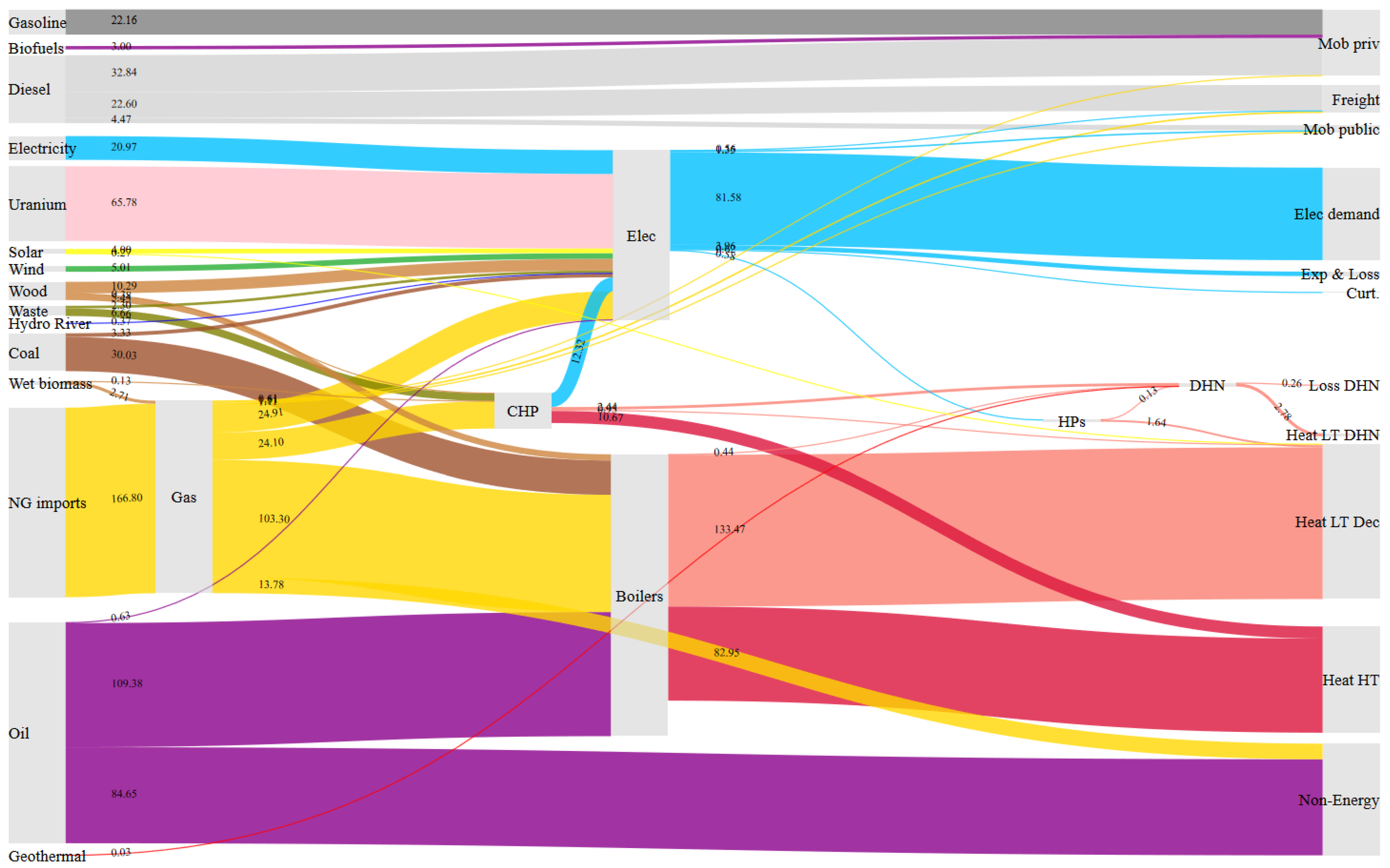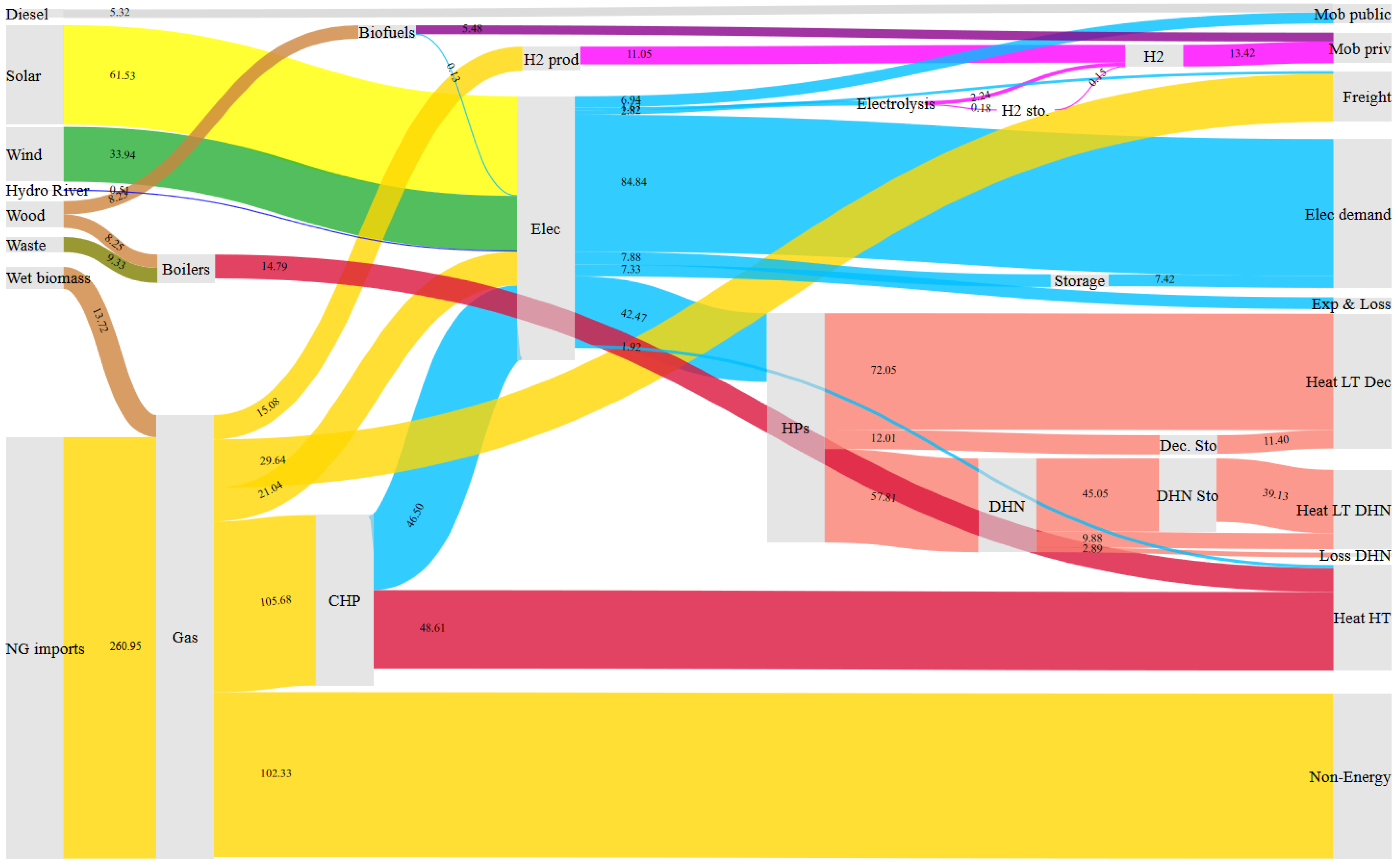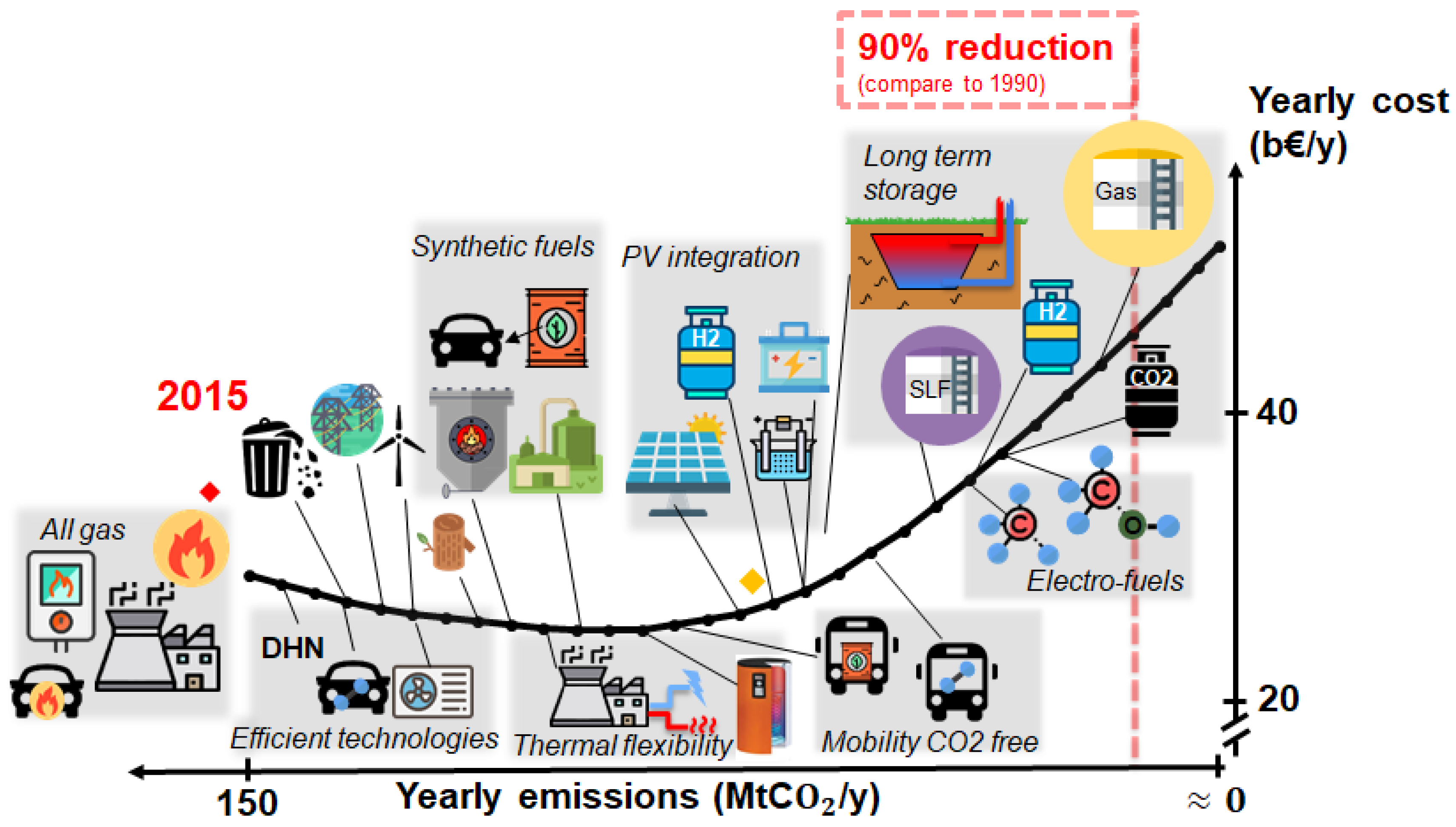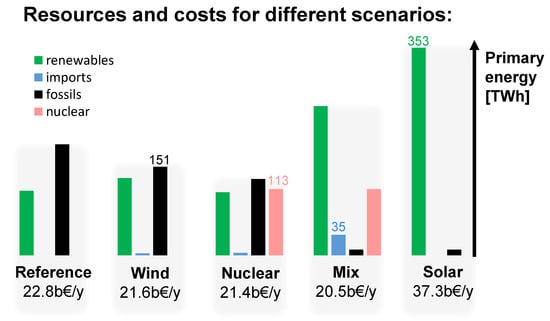Belgian Energy Transition: What Are the Options?
Abstract
:1. Introduction
2. Methodology
2.1. Conceptual Modelling Framework
2.2. Performance Indicators
3. Case Study: Belgium
3.1. Future Energy System Overview
3.2. Demonstration for the Year 2015
3.3. Scenario in 2035
3.3.1. Renewable Energy Potential
3.3.2. Energy Demand
3.3.3. Current Energy Policies
4. Results—Belgian Energy Transition
4.1. Transition without Solar Limitation
4.1.1. Primary Energy
4.1.2. Pareto Front and Integration of Technologies
4.2. Transition Accounting for Space Availabilities
4.3. What Are the Options?
4.3.1. Alternative Scenarios
- Solar—abundant solar: we assume a potential of 2864 km corresponding to 10% of Belgian land area (see Section 4.2).
- Nuclear—nuclear extended: we assume that the 5.6 GWe of nuclear plants have their lifetime extended.
- Wind—extra territorial offshore: we assume that Belgium can access to an additional potential of 3.5 GW in the North Sea.
- Elec.—electricity imports: we assume the capacity to double to 9 GW. In addition, the specific emissions of imported electricity is halved (241 kgCO-eq./MWh).
- RE-fuels—allow RE-fuel imports: we allow the importation of renewable fuels, including bioethanol, biodiesel, SNG, wood and H. Their cost are 50% higher than equivalent fossil fuels.
- Mix—mix between technologies: all the options are implemented.
4.3.2. Analysis of the Alternative Scenarios
4.3.3. Analysis of the Mixed Scenario
5. Discussion
5.1. The Role of Electrification
5.2. Limits of the Study
6. Conclusions
Supplementary Materials
Author Contributions
Funding
Conflicts of Interest
Abbreviations
| BEV | battery electric vehicle |
| CAPEX | capital expenditure |
| CCGT | combined cycle gas turbine |
| CHP | combined heat and power |
| CO2 | carbon dioxide |
| DHN | district heating network |
| EnergyScope TD | EnergyScope Typical Days |
| EROI | energy return on investment |
| EU | European Union |
| EUD | end-use demand |
| EUT | end-use type |
| FEC | final energy consumption |
| FPB | Federal Planning Bureau |
| GDP | gross domestic product |
| GHG | greenhouse gas |
| GWP | global warming potential |
| H2 | hydrogen |
| HP | heat pump |
| IEA | International Energy Agency |
| IGCC | integrated gasification combined cycle |
| LFO | light fuel oil |
| LP | linear programming |
| NG | natural gas |
| OPEX | operational expenditure |
| PHEV | plug-in hybrid electric vehicle |
| PHS | pumped hydro storage |
| PV | photovoltaic |
| RE | renewable energy |
| SLF | synthetic liquid fuel |
| SNG | synthetic natural gas |
| TD | typical day |
| TS | thermal storage |
| TSO | transmission system operator |
Appendix A. Methodology and Demonstration Details
Appendix A.1. Technologies Related to Synthetic Fuels

Appendix A.2. Energy Demand Calculation
Appendix A.3. Comparison for the Year 2015
| 2015 | Model | ||||
|---|---|---|---|---|---|
| Primary energy consumption (TWh) | Gasoline | 22.16 | |||
| Diesel | 59.91 | ||||
| Oil | 110.01 | ||||
| N.E. oil | 84.84 | 84.65 | |||
| Total Oil | 280.93 | 276.72 | −4.2 | −1.5% | |
| Gas | 150.56 | 153.02 | |||
| N.E. gas | 11.45 | 13.78 | |||
| Total Gas | 162.02 | 166.8 | 4.78 | 2.95% | |
| Coal | 34.5 | 33.35 | |||
| N.E. coal | 2.49 | ||||
| Total Coal | 36.98 | 33.35 | −3.63 | −9.81% | |
| Nuclear | 78.11 | 65.78 a | −12.32 | −15.78% | |
| Elec. Imp. | 20.94 | 20.97 | 0.03 | 0.13% | |
| Solar PV | 3.05 | 3.38 | 0.33 | 10.86% | |
| Solar th | 0.26 | 0.27 | 0.01 | 5.37% | |
| Wind | 5.56 | 5.01 | −0.55 | −9.9% | |
| Hydro | 0.32 | 0.37 | 0.05 | 15.06% | |
| Geothermal | 0.04 | 0.03 | −0.01 | −18.58% | |
| Wood | 15.34 | 16.12 | 0.77 | 5.05% | |
| Biogas | 2.66 | 2.53 | −0.12 | −4.58% | |
| Biofuels | 3.33 | 3 | −0.33 | −9.95% | |
| Total RE | 30.55 | 30.71 | 0.16 | 0.51% | |
| RE. | 4.39 | ||||
| non RE. | 6.32 | ||||
| Total Waste | 10.71 | 8.97 | −1.74 | −16.28% | |
| Total Energy | 620.24 | 603.31 | −16.94 | −2.73% | |
| GHG emissions b (MtCO2/y) | 92.5−97.8 c | 96.91 | 1.76 | 1.85% | |
Appendix B. Additional Results
Appendix B.1. Technologies Deployment in the Reference Scenarios







Appendix B.2. CO2 Optimum Scenario with Limited Solar
Appendix B.2.1. CO2 Optimum—Hourly Integration of Stochastic Renewable Energy

Appendix B.2.2. The Role of Storage


Appendix B.3. Yearly Energy Balances


References
- Beveridge, R.; Kern, K. The ‘ Energiewende ’ in Germany: Background, Development and Future Challenges. Renew. Energy Law Policy Rev. 2013, 4, 3–12. [Google Scholar]
- Dangerman, A.T.; Schellnhuber, H.J. Energy systems transformation. Proc. Natl. Acad. Sci. USA 2013, 110, 549–558. [Google Scholar] [CrossRef] [PubMed] [Green Version]
- Van Den Bergh, J.C. Policies to enhance economic feasibility of a sustainable energy transition. Proc. Natl. Acad. Sci. USA 2013. [Google Scholar] [CrossRef] [PubMed] [Green Version]
- European Commission. EU Reference Scenario 2016—Energy, Transport and GHG Emissions—Trends to 2050; European Commission: Brussels, Belgium, 2016; p. 220. [Google Scholar] [CrossRef]
- Gusbin, D.; Devogelaer, D. Le Paysage Énergétique Belge à L’horizon 2050: Perspectives à Politique Inchangée. Available online: https://www.plan.be/publications/publication-1728-fr-le+paysage+energetique+belge+a+l+horizon+2050+perspectives+a+politique+inchangee (accessed on 3 January 2020).
- Elia System Operator. Electricity Scenarios for Belgium towards 2050; 2017; p. 152. Available online: https://www.elia.be/en/publications/studies-and-reports (accessed on 3 January 2020).
- Van Stiphout, A.; De Vos, K.; Deconinck, G. Operational flexibility provided by storage in generation expansion planning with high shares of renewables. In Proceedings of the International Conference on the European Energy Market (EEM), Lisbon, Portugal, 19–22 May 2015. [Google Scholar] [CrossRef]
- Meinke-Hubeny, F.; De Oliveira, L.P.N.; Duerinck, J. Energy Transition in Belgium—Choices and Costs. 2017. Available online: https://www.energyville.be/energy-transition-belgium-choices-and-costs (accessed on 3 January 2020).
- Limpens, G.; Jeanmart, H. Electricity storage needs for the energy transition: An EROI based analysis illustrated by the case of Belgium. Energy 2018, 152, 5–8. [Google Scholar] [CrossRef]
- Devogelaer, D.; Duerinck, J.; Gusbin, D.; Marenne, Y.; Nijs, W.; Orsini, M.; Pairon, M. Towards 100% Renewable Energy in Belgium by 2050. Technical report. 2013. Available online: https://energie.wallonie.be/servlet/Repository/130419-backcasting-finalreport.pdf?ID=28161 (accessed on 3 January 2020).
- E3MLab. PRIMES Model—Detailed Model Description; E3MLab/ICCS at National Technical University of Athens: Athens, Greece, 2014; p. 155. [Google Scholar]
- Lund, H. EnergyPLAN Advanced Energy System Analysis Model. 2007. Available online: https://www.energyplan.eu/ (accessed on 3 January 2020).
- Fishbone, L.G.; Abilock, H. Markal, a linear-programming model for energy systems analysis: Technical description of the bnl version. Int. J. Energy Res. 1981, 5, 353–375. [Google Scholar] [CrossRef]
- Limpens, G.; Moret, S.; Jeanmart, H.; Maréchal, F. EnergyScope TD: A novel open-source model for regional energy systems. Appl. Energy 2019, 255, 113729. [Google Scholar] [CrossRef]
- Limpens, G. Belgian EnergyScope TD Model. Available online: https://github.com/energyscope/EnergyScope/tree/Limpens_Belgian_2020_code (accessed on 3 January 2020).
- Flaticon. Available online: https://www.flaticon.com/ (accessed on 3 January 2020).
- International Energy Agency. Definitions. Available online: https://www.iea.org/ (accessed on 3 January 2020).
- Moret, S. Strategic Energy Planning under Uncertainty. Ph.D. Thesis, EPFL, Lausanne, Switzerland, 2017. [Google Scholar] [CrossRef]
- Quaschning, V. Regenerative Energiesysteme: Technologie-Berechnung-Simulation; Carl Hanser Verlag GmbH Co KG: Munich, Germany, 2015; pp. 1–12. [Google Scholar] [CrossRef]
- Moro, A.; Lonza, L. Electricity carbon intensity in European Member States: Impacts on GHG emissions of electric vehicles. Transp. Res. Part D Transp. Environ. 2018, 64, 5–14. [Google Scholar] [CrossRef] [PubMed]
- Weidema, B.P.; Bauer, C.; Hischier, R.; Mutel, C.; Nemecek, T.; Reinhard, J.; Vadenbo, C.O.; Wernet, G. Overview and Methodology. Data Quality Guideline for the Ecoinvent Database Version 3. Ecoinvent Report 1(v3); Technical Report 1; The Ecoinvent Centre: St. Gallen, Switzerland, 2013. [Google Scholar]
- Limpens, G.; Jeanmart, H. Quantification of electricity storage needs for Belgium energy transition: A sensitivity analysis based on EROI. In Proceedings of the 31st International Conference on Efficiency, Cost, Optimization, Simulation and Environmental Impact of Energy Systems 2018, Guimarães, Portugal, 17–22 June 2018; pp. 5–8. [Google Scholar]
- Hodges, J.; Dewar, J. Is It You or Your Model Talking? A Framework for Model Validation; Technical report; Rand: Santa Monica, CA, USA, 1992. [Google Scholar]
- Craig, P.P.; Gadgil, A.; Koomey, J.G. W HAT C AN H ISTORY T EACH U S ? A Retrospective Examination of Long-Term Energy Forecasts for the United States. Annu. Rev. Energy Environ. 2002, 27, 83–118. [Google Scholar] [CrossRef] [Green Version]
- European Commission - Eurostat. Energy Balance Sheets—2016 Data—2018 Edition; European Commission - Eurostat: Brussels, Belgium, 2018. [Google Scholar] [CrossRef]
- Eurostat. Energy Balance Sheets—2015 DATA; European Commission - Eurostat: Brussels, Belgium, 2017; pp. 52–53. [Google Scholar] [CrossRef]
- European Commission. Modelling Tools for EU Analysis. Available online: https://ec.europa.eu/clima/policies/strategies/analysis/models_en (accessed on 3 January 2020).
- Delmer, A.; Rorive, A.; Stenmans, V. Dix ans de geothermie en Hainaut. Bull. Soc. Belg. De Geol. 1997, 105, 77–85. [Google Scholar]
- Vlaamse Instelling voor Technologisch Onderzoek. VITO Website. Available online: https://vito.be/nl/diepe-geothermie/balmatt-site (accessed on 3 January 2020).
- Haimes Yv, Y.; Lasdon, L.S.; Wismer Da, D. On a bicriterion formation of the problems of integrated system identification and system optimization. IEEE Trans. Syst. Man Cybernetics 1971, SMC-1, 296–297. [Google Scholar] [CrossRef]
- Danish Energy Agency. Technology Data for Energy Plants for Electricity and District Heating Generation—February 2019; Danish Energy Agency: København, Denmark, 2019. [Google Scholar]
- Institut Royal Météorologique. Available online: https://www.meteo.be/fr/climat/atlas-climatique/cartes-climatiques/rayonnement-solaire/rayonnement-solaire-global/annuel (accessed on 3 January 2020).
- European Commission—Eurostat. Statistical Pocketbook 2017; Publications Office of the European Union: Luxembourg, 2017; Volume 31, pp. 474–478. [Google Scholar] [CrossRef]
- Hambÿe, C.; Hertveldt, B.; Michel, B. Belgium’s Carbon Footprint - Calculations Based on a National Accounts Consistent Global Multi-Regional Input-Output Table; Technical Report; Federal Planning Bureau, Belgium: Brussels, Belgium, September 2017. [Google Scholar]
- Prina, M.G.; Lionetti, M.; Manzolini, G.; Sparber, W.; Moser, D. Transition pathways optimization methodology through EnergyPLAN software for long-term energy planning. Appl. Energy 2019, 235, 356–368. [Google Scholar] [CrossRef]
- Rosa, R. The Role of Synthetic Fuels for a Carbon Neutral Economy. J. Carbon Res. 2017, 3, 11. [Google Scholar] [CrossRef] [Green Version]
- Paardekooper, S.; Lund, R.S.; Mathiesen, B.V.; Chang, M.; Petersen, U.R.; Grundahl, L.; David, A.; Dahlbaek, J.; Kapetanakis, L.A.; Lund, H.; et al. Heat Roadmap Belgium. Available online: https://vbn.aau.dk/en/publications/heat-roadmap-belgium-quantifying-the-impact-of-low-carbon-heating (accessed on 3 January 2020).
- International Energy Agency. CO2 Emissions from Fuel Combustion 2017—Highlights. Int. Energy Agency 2017, 1, 1–162. [Google Scholar] [CrossRef]
- Limpens, G.; Moret, S.; Guidati, G.; Li, X.; Maréchal, F.; Jeanmart, H. The role of storage in the Swiss energy transition. In Proceedings of the ECOS 2019—The 32nd International Conference on Efficiency, Cost, Optimization, Simulation and Environmental Impact of Energy Systems, Weoclaw, Poland, 23–28 June 2019; pp. 761–774. [Google Scholar]







| Multi- | Multi- | RE | Open | ||
|---|---|---|---|---|---|
| Study Focus | Authors | Sectors | Scenarii | Shares | Access |
| EU ref. scenario [4] | EC | ✓ | ✗ | 17.5% | ✓ |
| Unchanged policies [5] | FPB | ✓ | ✗ | 20% | ✓ |
| Electricity scenarios [6] | ELIA | ✗ | ✓ | 80%elec. | - |
| Electricity storage [7] | KUL | ✗ | ✓ | 50%elec. | ✓ |
| Energy transition [8] | EV | ✓ | ✓ | 50%elec. e | ✓ |
| Electricity storage [9] | UCL | ✗ | ✓ | 100%elec. | - |
| 100% renewable [10] | group | ✓ | ✓ | 100% | ✓ |
| Combustion | Overall | |
|---|---|---|
| Resources | (kgCO-eq./MWhfuel) | |
| Elec. Import | 0 | 482 |
| Gasoline | 250 | 345 |
| Diesel | 270 | 315 |
| light fuel oil (LFO) | 280 | 311 |
| natural gas (NG) | 200 | 267 |
| Waste | 250 | 150 |
| Uranium | 0 | 3.9 e |
| Coal | 340 | 401 e |
| Biomass (All) | 0 | 11.8 |
| Technology | 2015 | max. Potential | Units | |
|---|---|---|---|---|
| Electricity production | photovoltaic | 3.85 | (no limit) | (GW) |
| onshore wind | 1.18 | 10 | (GW) | |
| offshore wind | 0.69 | 3.5 | (GW) | |
| hydro river | 0.11 | 0.120 | (GW) | |
| geothermal | 0 | ≈0 | (GW) | |
| Heat production | geothermal | ≈0 | ≈0 | (GW) |
| cen. solar th. | 0 | (no limit) | (GW) | |
| dec. solar th. | ≈0 | (no limit) | (GW) |
| Sources | 2015 | max. Potential | Units | |
|---|---|---|---|---|
| Imported synthetic fuels | bioethanol | 0.21 | 0 | (TWh) |
| biodiesel | ≈ 0 | 0 | (TWh) | |
| SNG | 0 | 0 | (TWh) | |
| H | 0 | 0 | (TWh) | |
| Biomass | woody | 13.9 | 16.48 | (TWh) |
| wet | 11.57 | 13.72 | (TWh) | |
| Waste (non RE) | 7.87 | 9.33 | (TWh) | |
| Units | 2015 | 2035 | |||
|---|---|---|---|---|---|
| Population | Mpers. | 11.24 | 13.4 | 2.2 | |
| GDP | b€2013 | 385 | 531 | 146 | |
| End use demand | Electricity | TWh | 81.6 | 91.9 | 10.3 |
| Heat High-Temp. | TWh | 84.7 | 65.3 | −19.4 | |
| Heat Low-Temp. | TWh | 136.2 | 132.5 | −3.7 | |
| Mobility pass. | Mpass.-km | 158 | 194 | 36 | |
| Freight | Mt-km | 66 | 98 | 32 | |
| Non-Energy | TWh | 98.4 | 102.3 | 3.9 | |
| Ref. | Sol. | Nuc. | Geo. | Wind | Elec. | Fuels | Mix | Units | |
|---|---|---|---|---|---|---|---|---|---|
| Capa. extra | - | 678 | 5.6 | 4+4 | 3.5 | 4.5 | - | - | (GW) |
| Prod. extra | - | 670 | 41.7 | 59.9 | 23.5 | 39.4 | 300 | - | (TWh/y) |
| CO optimum: | |||||||||
| Emissions | 50 | 1.8 e | 35 | 35 | 40 | 45 | 1.8 e | 2.2 e | (MtCO2/y) |
| Cost | 22.8 | 37.3 | 21.4 | 21.9 | 21.6 | 22.8 | 29.9 | 20.5 e | (b€/y) |
| Fossils | 179.7 | 0 | 120.3 | 122.6 | 141.5 | 165.4 | 0 | 0 | (TWh/y) |
| Cost optimum: | |||||||||
| Emissions | 75 | 75 | 60 | 60 | 65 | 70 | 70 | 35 | (MtCO2/y) |
| Cost | 20.9 | 20.9 | 19.7 | 20.3 | 19.9 | 20.9 | 20.9 | 18.6 | (b€/y) |
| Fossils | 254.2 | 254.2 | 195.8 | 197.7 | 217.3 | 241.4 | 234.9 | 108.2 | (TWh/y) |
© 2020 by the authors. Licensee MDPI, Basel, Switzerland. This article is an open access article distributed under the terms and conditions of the Creative Commons Attribution (CC BY) license (http://creativecommons.org/licenses/by/4.0/).
Share and Cite
Limpens, G.; Jeanmart, H.; Maréchal, F. Belgian Energy Transition: What Are the Options? Energies 2020, 13, 261. https://doi.org/10.3390/en13010261
Limpens G, Jeanmart H, Maréchal F. Belgian Energy Transition: What Are the Options? Energies. 2020; 13(1):261. https://doi.org/10.3390/en13010261
Chicago/Turabian StyleLimpens, Gauthier, Hervé Jeanmart, and Francois Maréchal. 2020. "Belgian Energy Transition: What Are the Options?" Energies 13, no. 1: 261. https://doi.org/10.3390/en13010261
APA StyleLimpens, G., Jeanmart, H., & Maréchal, F. (2020). Belgian Energy Transition: What Are the Options? Energies, 13(1), 261. https://doi.org/10.3390/en13010261






